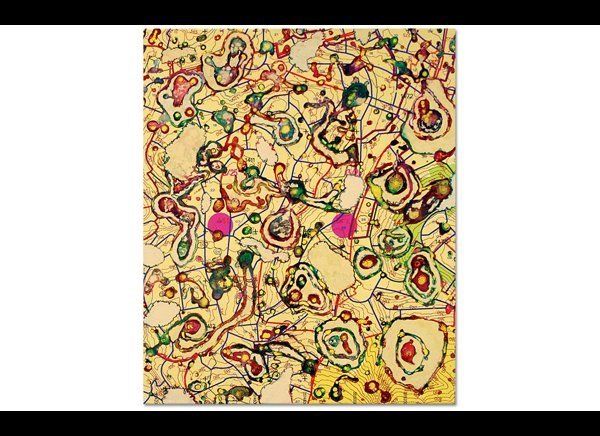"Oh! Blessed rage for order, pale Ramon,
The maker's rage to order words of the sea,
Words of the fragrant portals, dimly-starred,
And of ourselves and of our origins,
In ghostlier demarcations, keener sounds."
"The Idea of Order at Key West," Wallace Stevens
Monasteries sanctify space and time with ritual and prayer. Cristina Barroso sanctifies them with the painterly tagging of maps, calendars, and other abstractions of space and time.
She begins some of the work with maps, infographic descriptions of a moment out of time and space. Maps have graphic qualities -- color, line, and shape. They're verifiable, schematic, and flat. But texture them with memories, feelings, and impressions and you have a living, dynamic, multi-dimensional document, the particulars of which may be private but which nonetheless universalize the experience of any voyage from A to B, be it from specific place to specific place or, more generally, of a journey through life. The accumulation of these overlays results in a richly annotated overview of the trip, the digital equivalent of hyperlinks in a web document, expanding exponentially into the ether.
She uses maps and photographs as a literal and metaphorical base over which, with confident, flowing brushstrokes, she paints wispy, diaphanous letters, shapes, and lines that are as whimsical as they are descriptive. The words, some abbreviated, some truncated, point to the names of constellations, places on a map, days of the week, and airports. The lines suggest the concentric circles in the cross-section of a tree trunk (to tell its age); political boundaries; the connect-the-dot arrangements of stars; and the cross hatching of roads. She surgically isolates and then poetically rearranges these elements, the better to highlight the tension between the facts of a journey and the experience they describe.
The result is like looking at someone else's memory of a place, an area, either from above looking down or down looking up. It's akin to the way a map (places, stars) presents static, frozen, and abstracted expressions of something while the experience of it is fleeting, dynamic, and poetic. The words and numbers become formal elements, a concerto of livid life. It maps, regardless of magnitude, the paucity of attempts to simply enumerate a prosaic journey ("If it's Tuesday, it must be Belgium") because time and space -- and our relationship with both -- are not lassoed but continue to evolve, tectonically, astrophysically, and emotionally, both forward and beyond. It situates us in the flow of experience, here, there, and everywhere.
Her work provides perspective, a frame of reference: being both in and beyond something at the same time. Her work exquisitely articulates the omniscience of all-at-onceness, layering the "Just the facts, m'am" institutionalization of space and time with the experience of living within it. It's a comforting body of work, heady and yet anchored, imaginative and yet pragmatic: feet for the most part planted on the ground while the soul soars. That she does so with such precision and feeling is monumental.
As a crafter of secular and existential Books of Hours, as a cartographer of the human psyche, Barroso commemorates past attempts to map time and space as well as shares the journal of her passage through them, idiosyncratic, subjective, not bound by the very thing that she's commemorating. A celebration of finding a place within the flux of life, messy, perhaps, a little muddled, but certainly parlayed by a vantage point that shows how much she has the process under control.
And that's how her paintings read, like entries in a journal, a blank journal imprinted with days of the week and locations terrestrial and beyond. She begins with an acknowledgment of the givens, with descriptions of time and place, and then fills in the blank spaces with temporal memories and impressions. Israel, Germany, and Brazil -- she's been there. Stars in the sky - she's seen them. Not just that, they mean something. These excursions Here and There are available to anyone: they're our common currency. But what make them personal, what make them hers, are the marks she leaves. These Proustian recollections show not just that she was there but provide evidence that the whole thing meant something in the first place.
